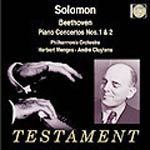
Piano Concerto No 1 & 2 (Rec 1956 & 1952)
 $38.00
Out of Stock
$38.00
Out of Stock6+ weeks add to cart
BEETHOVEN
Piano Concerto No 1 & 2 (Rec 1956 & 1952)
Solomon (piano) Philhamonia Orchestra. Herbert Menges & Andre Cluytens
[ Testament / CD ]
Release Date: Friday 7 December 2001
This item is currently out of stock. It may take 6 or more weeks to obtain from when you place your order as this is a specialist product.
Solomon is among the most deeply revered of all pianists
Solomon (1902-1988; full name: Solomon Cutner) is among the most deeply revered of all pianists, a man whose career was tragically terminated by illness at the age of fifty-four, but whose serene and magisterial performances place him among the keyboard immortals.
Unlike his distinguished colleagues (notably Dame Myra Hess and Sir Clifford Curzon), Solomon was a child prodigy who survived his early success (at once painful and glittering) to become a mature artist. A protégé of Mathilde Verne (herself a pupil of Clara Schumann), he later studied with Lazare Levy whose students included such luminaries as Clara Haskil and Alexander Uninsky. Yet it is difficult not to equate Solomon with a wholly personal and idiosyncratic perfection, with years of unremitting focus and discipline, almost as if he was in quest of the Holy Grail. His way of fusing all the qualities, of making technique and musicianship inseparable considerations, was his own secret, and his eloquence was deeply admired by pianists as celebrated as Clifford Curzon, Artur Rubinstein, Rudolf Serkin and Gerald Moore, and by musicians as richly diverse as Sir Arthur Bliss (whose Piano Concerto was given its first performance by Solomon in New York in 1939), Dame Janet Baker and Eugene Ormandy
Solomon neither courted nor provoked controversy. Abram Chasins may have seen him as part of a "gracious assemblage that had long breathed the reposeful air of England" but, less quaintly, he also noticed Solomon's "proportionate grandeur that instead of seeming to lack power appeared not to desire it". Others, too, have confirmed Solomon's cardinal characteristics, his subordination of detail to the whole (his supreme architectural mastery) and his selfless concern with creator rather than re-creator, with composer rather than pianist. In this sense Solomon's 'matchless austerity', his capacity to allow 'all pianistic vanity to fall away', made him, like Dinu Lipatti, a true modernist. Many of his predecessors from the so-called Golden Age of Pianists often used a composer as a springboard for their own egotism and excess. For them the performer came first, the composer a poor second. With Solomon the reverse is true, and the results are both unadorned and transcendental.
In 1977 I was invited by Bryan Crimp (then of EMl) to write a tribute to accompany the reissue of Solomon's performances of 18 Beethoven piano sonatas. Later, in 1994, Bryan paid his own tribute in his book, Solo - The biography of Solomon, a sensitive and acute portrait of a great pianist cut down in his prime. Today, at the start of the millennium, it is warming and reassuring to find Solomon's Beethoven as luminous, masterly and selfless as ever. Indeed, his musical calibre seems doubly unassailable, a beacon of light in a world alive with every sort of meretriciousness or falsity; of 'spin' and 'P.R.' 'imagining' and the like.
Again, Solomon could never be confused with so many of today's journeymen of the keyboard, moving from concert to concert with little thought for much beyond their own celebrity. Selfessly devoted to an Olympian cause he sought only, in his own words, to "live down his reputation as a prodigy" and evolve from 'performer' to 'artist'. How calmly and magestically he allows Beethoven his own voice in the Emperor Concerto unfurling the opening flourishes as if grandly and freely improvising. How typical, too, is that profound simplicity in the central Adagio and the sort of lucidity only achieved by years of the most concentrated work, and a complete inner musical assurance. His finale matches all these qualities, a true dance of the gods, commanding, delicate and luminous as required, never forced or pressured.
In this sense you could say that Solomon mirrors Beethoven's awe and affection for Mozart, celebrating grace as well as power, living proof of Shakespeare's assertion "O! it is excellent/To have a giant's strength, but it is tyrannous/To use it like a giant". In both Mozart Sonatas the perfection of Solomon's pianism exists in absolute harmony with his musicianship making the one inseparable from the other. His first movement to K. 576 is a true and sparkling allegro rather than a frantic or headlong presto while in the Adagio his superfine yet natural shading takes on the quality of a rich human discourse, questioning and answering, challenging and resolving. Solomon was never the sort of pianist to confuse first movements with finales and vice-versa and the finales of both Sonatas are exceptionally fast. That they are marvels of poise as well as dexterity at once suggests one of many cardinal attributes. Here and elsewhere all expressive markings are so absorbed into the general on-going argument that while they are present they are at the same time barely perceptible.
Doubtless, were he still alive he would have disapproved of such comments, sensing an adulation alien to his essential nature. For him the re-creative artist seeks, however inadequately, to convey the composer's voice and hopefully, his character and essence. In such modesty lay his greatness. A pianist of the rarest skill, his warmth and humility shine through his serene and magisterial musicianship. To paraphrase some words by T.S. Eliot, from Solomon "the communication of the dead is tongued with a fire and assuagement beyond the language of the living."
© Bryce Morrison, 2000

